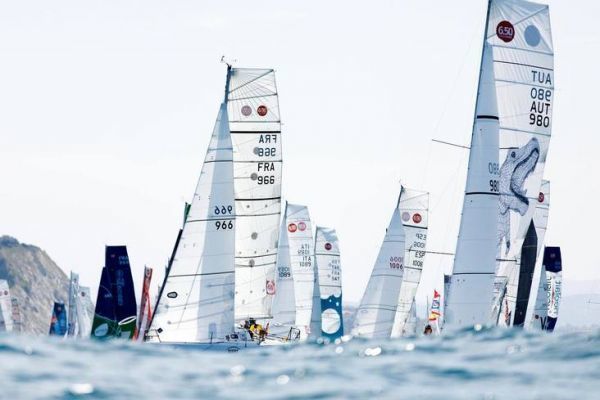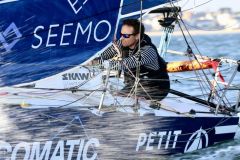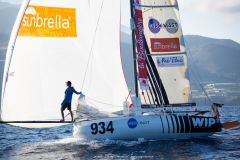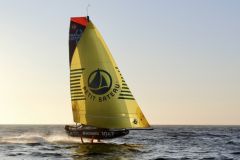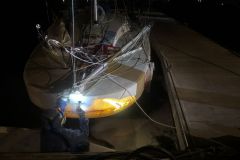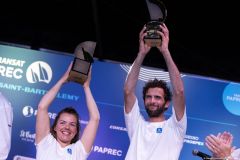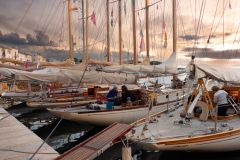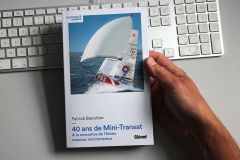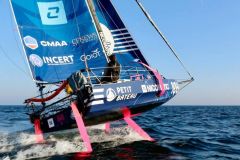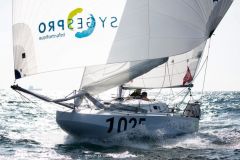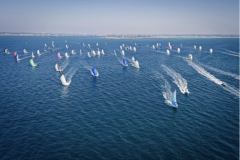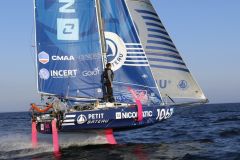Birth of the Mini Transat in 1977 in the United Kingdom
The story begins in 1977 in Penzance, UK, on the initiative of English journalist Bob Salmon. On April 8 of that year, 24 6.50 m yachts set off on the first Mini Transat, bound for Antigua via Tenerife in the Canaries. In 1985, the race arrived in France, linking Brest to Pointe-à-Pitre in Guadeloupe. It is organized by the Voile 6.50 association, which also manages the class rules. A new race is created, the Mini Fasnet, between Brittany and the famous Irish lighthouse.
Separate class management and race organization
The 1993 edition of the Mini Transat changed the course of events, and led to the creation of the Mini class. Annabelle Moreau, class secretary since 2001, tells us all about it: "The 1993 Mini Transat was very tough because of its weather conditions, a disappearance or even the first leg cancelled, with many beacons triggered."
In 1994, the directors of Voile 6.50 decided to create two separate entities, Cap Transat for race organization and the Mini class for rules, measurement and member management.
The initiative was spearheaded by a number of sailors, including skipper Dominique Bourgeois, Denis Hugues, long-time Mini Transat race director, and Philippe Naudin.
Annabelle explains: "At the time, the aim was to separate the two entities, as Voile 6.50 was both judge and jury as race organizer and class manager. Separating the two entities ensured the class that race organizers respected the rules in force. The policy and philosophy of the Mini class must be respected by members and organizers alike."
Also in 1994, the Mini rule was created to define a framework and specify draughts, air draughts and sails... Annabelle recalls an anecdote told by Denis Hugues: "They locked themselves away on the France, in La Rochelle, with several architects, including Pierre Rolland. They weren't to leave until the text was finished. They spent the weekend there. Today, it's still our base, even if it has evolved. It's the reference point for the Mini class. Before the creation of the rule, the only rule was the size set at 6.50 m."
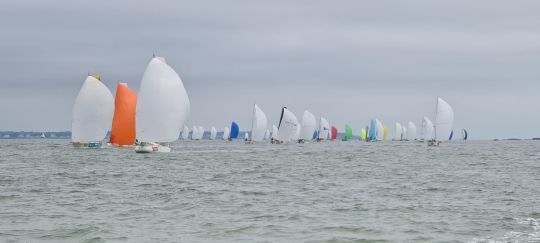
From the first cobbled-together Minis to the Mini 6.50s governed by a measurement system
Since 1994, almost 1,200 boats, including some 400 prototypes, have been registered by the class. No fewer than 140 architects have given birth to these small sailboats, including 19 original plans for production boats.
Before 1993, racers chose the number of their boat, so number 1 is not really the first Mini built. That said, before the creation of the measurement system, Muscadet and Surprise boats were known as Mini... Annabelle Moreau recalls: "The first proto built to win the race was American Express, in 1979."
Indeed, it's the prototypes that have marked the evolution of the class, thanks to a very open class rule that has enabled major technological innovations, from the pendulum keel to foils, and in recent years even round noses inspired by scows.
Better preparation for boats and sailors
In 1999, the class once again encountered a complicated Mini Transat. Of the 72 starters, only 37 made it to the finish. As a result, the class decided to tighten up the transatlantic qualification process and expand its calendar, as Annabelle Moreau explains.
"After the 1999 Mini, the board of directors at the time studied the course of the race by carrying out a survey among its members. In the end, the problem wasn't the boats, but the sailors' lack of experience. Until 1993, navigation was by sextant. You had to have a certain knowledge of navigation and the open sea. With the evolution of electronics, which made navigation easier, the Mini attracted less experienced sailors and fewer enlightened amateurs. In the end, the beacons had been triggered not because of any real danger, but more because of a lack of experience."
In 2000, the organization decided to include a 1,000-mile course, to be completed in a race. At the time, however, there were only three races on the calendar to complete the qualifying miles. The class therefore decided to create new races, of which there are some twenty today. Then the qualification was extended to 1500 miles to be completed in addition to the races.
Anabelle adds: "In 2001, the first Mini Transat with qualification was launched. We still had far fewer retirements. Compared with 1995, the boats and sailors arrive much better prepared. There are fewer losses on the big races. "
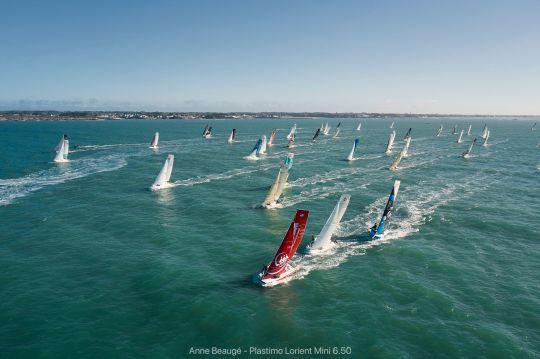
Cyclical class memberships
Over the past 35 years, the Mini class has also seen a significant increase in the number of members. Since 1994, no fewer than 4,562 sailors have passed through the Mini class. In 1999, the class had 245 members, rising to 500 in 2007.
Annabelle explains: "It's quite cyclical. There was a time when we attributed it to the difficulty of the Mini Transat. There was less enthusiasm behind it. That's less the case now. These days, it's still an economic and time-consuming investment. As there are a lot of people in the class, you have to sail a lot of miles to qualify, which means a lot of racing. There are waiting lists for the Mini Transat, but also for seasonal races. This can be a real turn-off for sailors. Since the peak in 2007, we've had a gradual decline until 2016."
Profiles that are less do-it-yourselfers and more engineers
The profiles of the sailors have also evolved over these 30 years. Although the Mini class is and remains an amateur class - such is its DNA - the more or less professional tinkerers and sailors of the time, who wanted to continue ocean racing, have been replaced by a large number of engineers and executives. There are also more production boats, as Annabelle explains: "Mini class members are less involved in the nautical world than they used to be. There are also more production boats, which used to be more anecdotal. It's clearly linked to profile. There's more financial ease and less time to spend on the boat. The move to prototypes is also scary, because even if the boats are reliable, there's always some tinkering to be done."
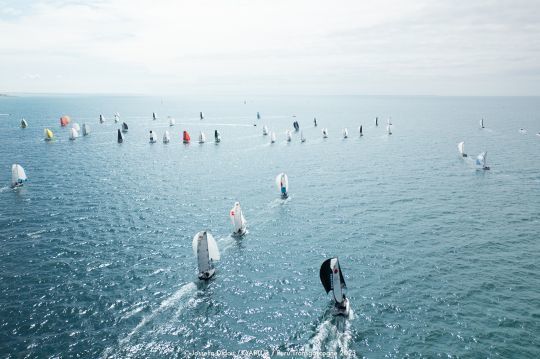
Promoting accessibility to the classroom
The class has always sought to respect its founding values: sailing affordable, simple, durable boats. But with the evolution of Mini 6.50 architecture, non-scows have little or no chance of success, especially in series production.
Annabelle Moreau explains this choice: "Accessibility is very important for the class. A 20-year-old boat costs less than a new one, and in terms of sustainable development, the longer its lifespan, the less it pollutes. We want boats that are still capable of sailing to do so. For 5 years, we've been looking at ways of continuing to attract members. We had already introduced the "Good Performance" label. This is awarded in each category - Proto and Series - by the winners to an older boat that has performed well. It also forces the winners to look at what's going on behind them."
The Mini Transmanche, a regatta running from Caen to Ouistreham in August 2024, is reserved for the older generations: prototypes built before 2009 and production boats before 2012.
Annabelle continues: "All the races are open to all boats, with the exception of the Mini Transmanche. The aim is to give them a bonus of qualifying miles - 500 miles single-handed - and also to bring a focus to an older boat. When the Mini class rules were created, the aim was never to throw a boat in the garbage can. If a boat that has already raced doesn't comply with the rules, we ask for an exemption if it's not a safety-related problem."
Today, the values and philosophy of the Mini class have not changed, as Annabelle Moreau explains in conclusion: "The DNA of the class is to develop a seafaring spirit, conviviality and determination. It's still there. Everyone sees the Mini spirit wherever they want. Some things never change. When it comes to finishes, everyone's there, even if it's a little less obvious during the season's races. And there's a real spirit of mutual support, even on the water!"

 /
/ 